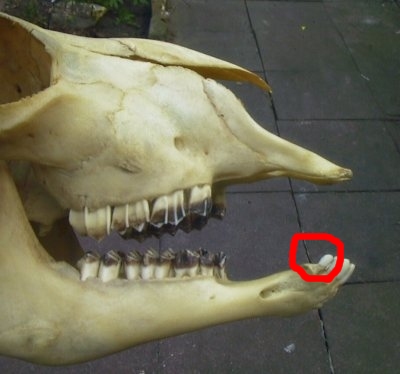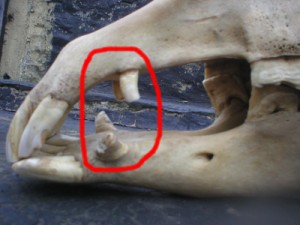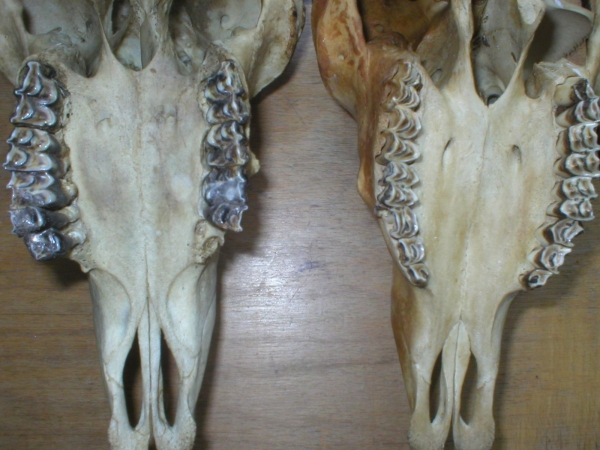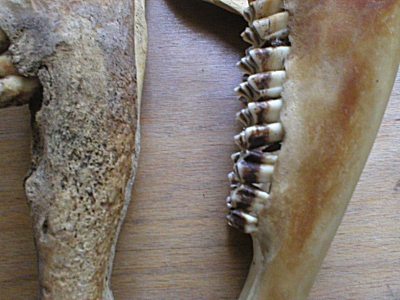Teeth
Mammals have four types of teeth which vary in shape and function according to the area in the mouth they are located. The teeth at the front of the mouth are chisel-like in shape, these are the incisors. Behind these are teeth which are conicle in shape, usually rather long and end with a point. These teeth are the canines. Behind the canines are the cheek teeth which are used for chewing, these teeth are usually flatter in shape. There are two types of cheek teeth. The premolars which lay behind the canines, and the molars which lay behind the premolars. Molars are larger than premolars.
The number of each teeth type an mammal has varies between species and not all mammals have all four teeth types. Rodents and lagomorphs, for example, do not have canines. Lagomorphs can be distinguished from rodents in that they have a second set of smaller incisors behind the first pair in the upper jaw.
lagomorph
Rabbit (Oryctolagus cuniculus) |
Canines
Canine teeth are generally associated with carnivores. These teeth are usually long and more or les cone shaped. In meat eating animals these teeth are designed to hold prey. Don't assume that all animals with canines are meat-eaters. Deer are typically herbivorous, however several species of deer do have canines, the function of these canines is believed to be for defence. Deer are distinquishable from carnivores in that deer do not have incisors in their upper jaw, instead they have a bony pad. To really confuse us, sheep and cattle are also regarded has having canines. These teeth are found in the mandible and look no different to their incisors.
 sheep (Ovis aries)- canine ringed in red |
Canines can also be a used to distinguish the males from females in some species. Male horses, for example, generally have canines, whereas females generally don't.
 Horse (Equus caballus)- canines ringed in red |
Premolars and Molars
Premolars and molars (generally refered to as "cheek teeth") are those found at the back of the mouth behind the cheeks. These teeth are used to chew food before it is swallowed. Cheek teeth vary in shape according to the diet of the animal they serve. To see examples of cheek teeth click on the links below:
|
Insectivore - insect eaters Herbivore - plant eaters Carnivore - meat eaters Omnivore - eaters of both plants and meat |
Age Concern
"Don't look a gift horse in the mouth" is probably an expression many of us have heard. If you were given a horse as a gift it was considered rude to look inside its mouth to find out its monetary value. What the devil are you talking about I hear you cry! Once of a day horses were highly valued both as working animals and as a mode of transport. A young healthy horse would generally be worth more than an old/unhealthy one because it would have a longer life span and thus you would get more work from it. In order to tell whether a horse was past its sell by date or not, one would take a peak at its teeth. The more worn down the teeth, the older the horse. Also if it had signs of abcessing, holes in the teeth etc the animal would loose its value. An animal that won't eat because of pain in the mouth won't last very long. In addition to this an animal in pain can be unpredictable. To this day, looking at the tooth wear of an animal is often used to estimate its age. Unfortunately this method of age defining is useless in animals whose teeth continue to grow throughout their lives. Rabbits, hares and some rodents have "rootless" teeth. These teeth do have roots, but unlike rooted teeth they don't taper off into a point beneath the gum, instead they remain open and the tooth continues to grow as it wears down. This is beneficial to gnawing animals who would quickly wear their teeth away if their teeth didn't continuously grow.
 The tooth wear on the animal to the left is more prominant than that on the right, indicating that the animal on the left is older |
Missing Teeth
Skull are often found with some teeth missing, but did they drop out during decompisition of the flesh or did the animal loose a tooth when it was alive? The easy way to tell the difference is to look at the area where the tooth should be. If the tooth fell out when the animal was alive you may find there is no hole in the jaw for that tooth. When a tooth drops out the bone around the hole where the root of the tooth was situated begins to close over. The bone knits together and forms a seam. Sometimes skulls are found where the tooth has been lost before death but the hole hasn't had chance to completely seal, if you look carefully at the hole you may see evidence of the bone beginning to knit, this often looks like a web of bone. Where the tooth has been lost after death the hole will look quite deep with no sign of the bone knitting together.
Abcess and tooth decay
The condition of an animals mouth can tell you something about its dental health. Some animals are prone to abcessing, I've seen this a lot in sheep skulls though it appears to be more common in older sheep. Abcesses are nasty and painful, they are caused by a build up of pus. If left untreated they can cause damage to the bone not to mention a lot of pain for the sufferer. The bone around the effected area swells out wards and often the bone around the effected area becomes porous.
 Sheep (Ovis aries) mandible |
